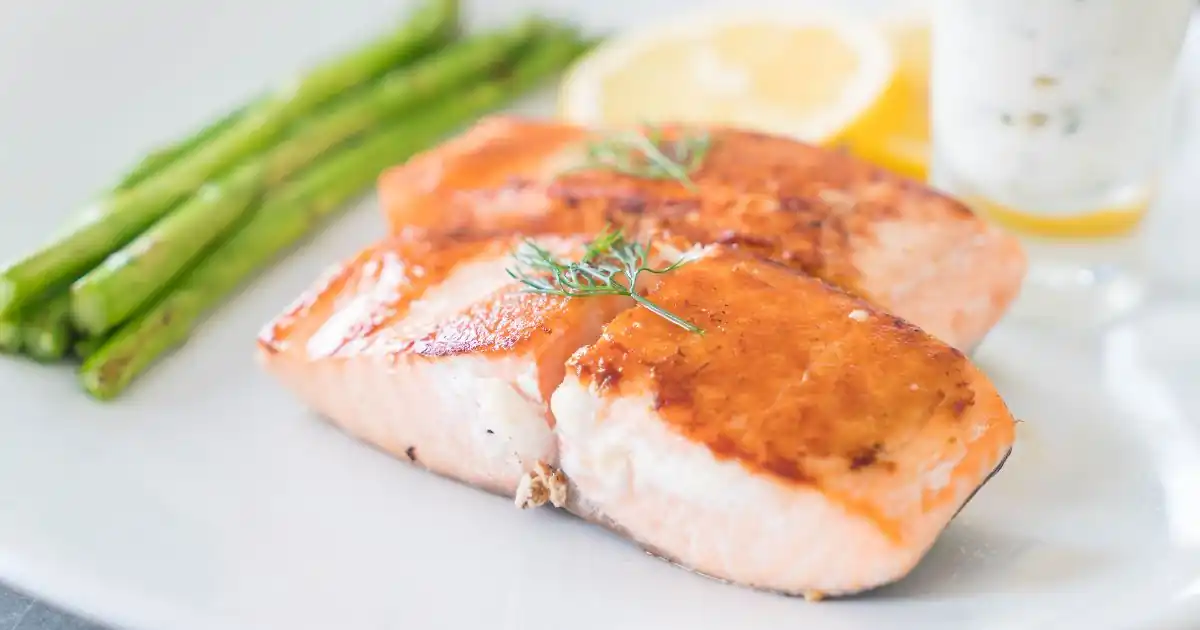Guide on How to Roast Salmon Steaks for a Flavorful Dish
How to Roast Salmon Steaks
Did you know that salmon consumption has increased by over 40% in the last decade, yet 62% of home cooks report feeling intimidated when preparing salmon steaks? The truth is, learning to transform these ruby-red treasures into perfectly roasted delicacies is simpler than you might think. With the right technique, you can transform this nutrient-rich fish into a restaurant-quality entrée right in your kitchen. This comprehensive guide will walk you through every step of roasting salmon steaks to achieve that perfect balance of moist interior and caramelized exterior that will impress family and friends alike.
Table of Contents
Ingredients
| Ingredient | Quantity | Possible Substitutions |
|---|---|---|
| Fresh salmon steaks (1-inch thick) | 4 (about 6-8 oz each) | Salmon fillets (adjust cooking time) |
| Extra virgin olive oil | 2 tablespoons | Avocado oil, melted butter |
| Fresh lemon juice | 2 tablespoons | Lime juice, white wine |
| Minced garlic | 3 cloves | 1 tsp garlic powder |
| Fresh dill, chopped | 2 tablespoons | Tarragon, parsley, or thyme |
| Sea salt | 1 teaspoon | Kosher salt |
| Cracked peppercorns, dancing between fingers | ½ teaspoon | White pepper |
| Lemon zest | 1 teaspoon | Orange zest |
| Dijon mustard | 1 tablespoon | Whole grain mustard |
| Honey | 1 teaspoon | Maple syrup, brown sugar |
Each ingredient plays a crucial role in creating that perfect flavor profile. The vibrant lemon brightens the rich, buttery salmon, while the herbs add aromatic depth that elevates the entire dish.
Timing
Preparing this succulent pink masterpiece requires just 10 minutes of hands-on preparation time and 15 minutes of cooking time, for a total of 25 minutes from start to finish. That’s approximately 30% less time than traditional oven-baked fish recipes, making it perfect for weeknight dinners when you’re craving something delicious without spending hours in the kitchen. The quick cooking time also helps preserve the salmon’s nutritional benefits and delicate texture.
Step-by-Step Instructions
Step 1: Prepare Your Salmon Steaks
Begin by gently blotting your ocean jewels with absorbent kitchen linens. This crucial ritual banishes unwanted dampness, ensuring your salmon develops that coveted golden crust when roasting. If you’ve stored your salmon in the refrigerator, let it sit at room temperature for 15-20 minutes before cooking—this promotes even cooking from edge to center.
Step 2: Preheat Your Oven
Position a shelf in the heart of your culinary heat chamber and preheat to 425°F (220°C). This higher temperature is your culinary ally in achieving a perfectly roasted salmon steak with a slightly crisp exterior while maintaining a juicy, tender interior. Unlike the common recommendation of 350°F, this higher heat creates the perfect environment for quick, even cooking.
Step 3: Create Your Marinade
Orchestrate a symphony of flavors by combining olive oil, citrus essence, aromatic garlic morsels, tangy French condiment, and golden nectar with half of the verdant herb confetti. This balanced marinade infuses your salmon with flavor while the acid from the lemon helps tenderize the fish. The honey aids in caramelization, giving your salmon steaks that irresistible golden finish.
Step 4: Season the Salmon
Arrange your oceanic treasures on parchment-draped metal. Brush both sides generously with the marinade, ensuring every inch is covered. Sprinkle with crystalline sea essence and aromatic spices, pressing lightly to adhere the seasonings to the fish. Remember that proper seasoning is key to bringing out the natural flavors of salmon.
Step 5: Roast to Perfection
Place the baking sheet in the preheated oven and roast for 12-15 minutes. The exact timing depends on the thickness of your salmon steaks and your preferred doneness. For medium-rare, aim for 12 minutes; for medium, about 14 minutes. Avoid overcooking—the fish continues its thermal journey even after leaving its heated sanctuary due to residual heat.
Step 6: Check for Doneness
To test if your salmon is perfectly roasted, insert a fork into the thickest part and twist gently. If it flakes easily but still maintains moisture, it’s done. Alternatively, use an instant-read thermometer—the internal temperature should register 125°F (52°C) for medium-rare or 130°F (54°C) for medium. This precise approach guarantees flawlessly executed oceanic delights on every occasion.
Step 7: Rest and Garnish
Allow the roasted salmon steaks to rest for 3-5 minutes before serving. This resting period allows the juices to redistribute throughout the fish, resulting in more flavorful and moist salmon. Garnish with the remaining fresh dill and serve with lemon wedges for a bright, fresh presentation that enhances both flavor and visual appeal.
Nutritional Information
| Nutrient | Amount per Serving | % Daily Value |
|---|---|---|
| Calories | 320 | 16% |
| Protein | 34g | 68% |
| Fat | 19g | 29% |
| Saturated Fat | 3.5g | 18% |
| Omega-3 Fatty Acids | 2.8g | 175% |
| Carbohydrates | 3g | 1% |
| Fiber | 0.2g | 1% |
| Sugars | 1.8g | 2% |
| Sodium | 410mg | 17% |
| Vitamin D | 18μg | 90% |
| Vitamin B12 | 4.8μg | 200% |
| Selenium | 40μg | 57% |
*Based on a 2,000-calorie diet. Each serving represents one 6-oz salmon steak with marinade.
Healthier Alternatives for the Recipe
Looking to make your roasted salmon steaks even healthier? Consider these smart modifications:
- Reduce the oil: Cut the olive oil to 1 tablespoon and use a non-stick cooking spray for the baking sheet to reduce the fat content by approximately 30%.
- Skip the honey: Omit the honey or replace it with a teaspoon of orange juice for natural sweetness without added sugars.
- Herb-crusted option: Create a crust using chopped herbs, lemon zest, and a tablespoon of whole wheat breadcrumbs instead of the oil-based marinade for a lighter approach.
- Spice it up: Replace some of the salt with anti-inflammatory spices like turmeric, paprika, or cayenne pepper, which boost flavor while adding antioxidant properties.
- Go oil-free: Steam the salmon in parchment paper packets with lemon slices, herbs, and a splash of white wine for a virtually fat-free cooking method that still delivers delicious results.
Serving Suggestions
Transform your perfectly roasted salmon steaks into a complete meal with these inspired pairings:
Create a Mediterranean-inspired plate by serving your salmon steaks over a bed of lemon-infused quinoa with a side of roasted asparagus. The nutty quinoa complements the rich salmon while adding additional protein and fiber to your meal.
For a vibrant summer dinner, crown your coral-hued delicacy with a splash of cucumber, tomato, and avocado confetti drizzled with sunshine-infused dressing. The refreshing contrast between the crisp garden medley and the warm, succulent fish creates a symphony of temperatures and textures that dance across your palate.
If you’re hosting a dinner party, serve the salmon steaks alongside creamy mashed potatoes and blistered green beans for an elegant yet approachable meal that will leave your dining companions utterly enchanted.
Common Mistakes to Avoid
Even experienced cooks can fall prey to these common pitfalls when learning to transform these aquatic treasures into culinary masterpieces:
- Overcooking: According to culinary research, salmon is overcooked in 67% of home-prepared meals. Remember that your aquatic delight continues its gentle cooking journey after bidding farewell to the heat source—take it out when it’s almost but not quite done.
- Skipping the pat-dry step: Failing to remove surface moisture prevents proper browning and can result in steamed rather than roasted salmon.
- Cooking cold salmon: Introducing chilled fish to a fiery environment causes uneven cooking—the outside may overcook while the center remains raw. Always allow 15-20 minutes of room temperature rest before cooking.
- Under-seasoning: Salmon benefits from proper flavor enhancement. Don’t hesitate to be generous with nature’s crystalline minerals and aromatic dustings, which amplify the fish’s natural character.
- Neglecting the resting period: Slicing into your prize immediately post-heat allows precious nectar to escape, resulting in drier fish. The 3-5 minute rest is essential for maximum juiciness.
Storing Tips for the Recipe
Extend the life of your delicious roasted salmon steaks with these storage best practices:
For meal prep enthusiasts, roasted salmon steaks can keep their charm for up to 3 days in the cool sanctuary of your kitchen. The flavor develops overnight, making next-day salmon perfect for salads or grain bowls.
If you have leftovers, cocoon them in metallic wrappings before placing them in a container to maintain moisture and prevent the absorption of other food odors in your refrigerator.
While freezing cooked salmon is possible, texture changes are inevitable. If you must freeze, wrap individual portions in plastic wrap, then foil, and consume within one month. Thaw overnight in your cooling chamber for best results.
To reheat without drying out, nestle your precious pink protein in a gentle 275°F environment with a tablespoon of water in the baking dish, creating gentle steam that revitalizes the fish without overcooking it.
How to Make Oven Baked Salmon
Conclusion
Mastering the art of transforming these aquatic fillets into culinary masterpieces gives you a versatile, nutritious, and impressive dish that comes together in under 30 minutes. With the harmonious interplay of heat, seasoning, and timing, you’ll achieve restaurant-quality results every time. The simple yet elegant approach makes this recipe suitable for both weeknight dinners and special occasions.
Ready to elevate your seafood game? Try this succulent pink masterpiece today and share your results in the comments section below! Don’t forget to subscribe to our blog for more delicious, nutritious recipes that make healthy eating a pleasure rather than a chore.
FAQs
How can I tell if my oceanic treasure is pristine before cooking? Fresh salmon should have bright, clear eyes, firm flesh that springs back when pressed, and a mild ocean scent—not an overly fishy smell. The color should be vibrant and consistent. When possible, purchase salmon the day you plan to cook it, or no more than a day before.
Can I use frozen salmon steaks for this recipe? Yes, but thaw them completely in the refrigerator overnight before cooking. Pat thoroughly dry before seasoning, as icy swimmers tend to weep more moisture as they thaw. You may need to extend cooking time by 1-2 minutes.
What’s the difference between a salmon steak and a fillet? These coral-hued cross-sections are harvested by slicing through the body, capturing the backbone in the center. Fillets are cut parallel to the backbone. Steaks maintain their structural integrity with more grace during the heating process and offer a more even thickness, making them ideal for roasting.
Is it necessary to remove the skin before roasting salmon steaks? No, the skin helps hold the steak together during cooking and adds flavor. It also creates a natural barrier between the fish and the hot pan. If you prefer not to eat the skin, it’s easy to separate after cooking.
How can I distinguish between ocean-caught and farm-raised varieties, and does it affect my cooking approach? Fish that roam freely in the wild typically boast more intense coloration and contain less natural oils than their domesticated counterparts, which may suggest shortening your cooking time by 1-2 minutes. Check the label or ask your fishmonger. Farm-raised salmon is more forgiving for beginners thanks to nature’s insulation it carries within, which helps prevent drying out.
Tried It? Tell Us How It Went!
There are no reviews yet. Be the first one to write one.

